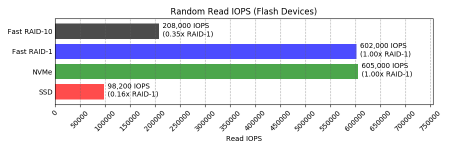Background ^
In the previous article, “Linux RAID-10 may not always be the best performer, but I don’t know why“, we discovered that a RAID-10 of two mismatched drives can perform 3 times worse at random reads than a RAID-1 of the same devices.
In my case the two devices were a Samsung PM983 NVMe and a Samsung SM883 SATA SSD. The NVMe is about 6 times faster than the SSD at random reads.
An explanation ^
I posted about my findings on the linux-raid mailing list and got a very helpful reply from Guoqing Jiang.
It seems that RAID-1 has an enhancement for non-rotational devices such that it will direct IO to the least-loaded device.
For rotational devices, the distance between the location of the sectors is more important than which device is least loaded, because switching spindles has a big penalty in seeking to the correct location.
This is not so for non-rotational devices like SSD and NVMe, so if a non-rotational and lightly loaded device is available, it is selected for IO. That is why with RAID-1 I saw most of the IOs going to the fast NVME device with a corresponding boost in performance compared to RAID-10.

The same enhancement has not been made for RAID-10. I do not know if this is just because no one got around to it yet, or if it’s because it may be technically harder (or impossible).
One thought on “Why Linux RAID-10 sometimes performs worse than RAID-1”